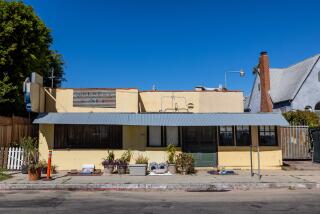HUNTINGTON BEACH : Historic Village’s Future Up in the Air
- Share via
Historic preservationists working to establish a park region dedicated to old Huntington Beach structures are discovering that balancing history and economics can be a tenuous, painstaking endeavor.
Members of community historic groups are brimming with ideas for the proposed historic village at Bartlett Park but recently have found themselves wrestling with the nagging dilemma of how to pay for it.
The preliminary plan for the village, which the City Council approved in July, calls for about half a dozen historic structures to be restored and located in a one-acre area atop a bluff at the park, which now includes the landmark Newland House site.
The city’s Historic Resources Board, which advises the council on preservation issues, has suggested that several old structures be included in the village, including a windmill and the downtown building that 85 years ago was City Hall. But, so far, proposals for generating income at the village have been uniformly rejected.
Prospective developers have nixed a series of modest commercial ideas suggested by city planners as being financially unworkable. For example, preservationists had strongly urged that one or more of the old homes be transformed into a bed-and-breakfast accommodation, thus creating income while emphasizing historic preservation.
Developers, however, argued that even several bed-and-breakfasts could not raise enough money to offset the cost, especially since the park, tucked away behind the Newland Center at Beach Boulevard and Adams Street, has poor street visibility.
Meanwhile, the first firm proposals offered by a developer, recently submitted to the city by a group of firms calling themselves the Bartlett Park Village Partners Development Co., were briskly scuttled by city planners and historic advisers, who complained that the plans were overly commercial.
Ruth Lambert, a city associate planner in charge of the project, said the firm’s bid included three separate proposals. They ranged from a village comprising a new restaurant and four or five historic structures, which would incorporate a series of shops, to an attraction composed of 10 or 11 old buildings, including as many as six shops, in addition to the new restaurant. Members of the city’s Historic Resources Board at a meeting this week sharply criticized the developer’s offer.
“That sounds to me like it’s no different than a commercial strip center,” said member Douglas Langevin. “And if this is just going to be another strip center, I’d rather see the (historic) buildings go down than be used that way.”
The city’s Historic Issues Committee, which includes representatives from the board, the city planning staff and other historic preservation groups, is now devising guidelines that more clearly define what the members want for the historic village, Lambert said.
More to Read
Sign up for Essential California
The most important California stories and recommendations in your inbox every morning.
You may occasionally receive promotional content from the Los Angeles Times.










